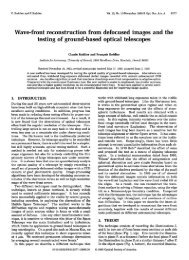ELECTRICAL DISTURBANCES APPARENTLYOF ... - Soft.belastro.net
ELECTRICAL DISTURBANCES APPARENTLYOF ... - Soft.belastro.net
ELECTRICAL DISTURBANCES APPARENTLYOF ... - Soft.belastro.net
- No tags were found...
You also want an ePaper? Increase the reach of your titles
YUMPU automatically turns print PDFs into web optimized ePapers that Google loves.
Jansky: Electrical Disturbances of Extraterrestrial Origin1397the earth would be between the source of the waves and the receiver.For the purpose of making a comparison between these curves andthose of Fig. 2, an average of the curves of Fig. 2 is shown in Fig. 9 bythe broken line. It will be seen that for the greater part of the time duringwhich the direction of arrival is above the horizon it lies between thecurves for a declination of 0 degrees and -20 degrees, giving a valueof roughly -10 degrees for the declination of the direction of arrival ofthe waves. In Fig. 3 the line XO is drawn with a declination of -10degrees and right ascension of 18 hours so that it represents the apparentdirection of arrival of the waves.Beyond the point where the direction of arrival drops below thehorizon, the average curve is not at all similar to the theoretical curvesof Fig. 9. However, for that portion of the curves the intensity is veryweak (see the curve at the right in Fig. 2) and the directions cannot bemeasured very accurately. Furthermore, as the time interval before orafter the direction of arrival coincides with the meridian of the receiveris increased, the waves must travel through an increasing thickness ofthe earth's atmosphere so that any bending of the waves caused by theionized layers would increase also. At the time the direction of arrivalcoincides with the meridian of the receiver this bending is confined tothe plane determined by the right ascension of the direction of arrival,and will therefore cause no error in the measurement of the right ascensionif the data used for its determination are taken at this time, ashas been done. It may, however, affect the measurement of the declination.At all other times, whatever bending the waves suffer willcause errors in both measurements and this bending might be the causeof the difference between the theoretical and actual curves noted.It may very well be that the waves that reach the receiver insteadof coming from a single point fixed in space originate in the earth'satmosphere, but are secondary radiations caused by some primaryrays of unknown character, coming from a source or sources fixed inspace, and striking the earth's atmosphere. If this is so the disturbancemeasured by the receiver is probably the summation of very manywaves of various intensities coming from secondary sources in theearth's atmosphere that are scattered over a considerable area. In thiscase the declination of the source of the primary rays may be considerablydifferent from that obtained from the curves; however, the measurementof its right ascension would not be affected appreciably ifmade in the manner described above.On the other hand it may be that the waves that reach the receiverare the primary waves themselves coming from a great manysources scattered throughout the heavens. In this case the direction



